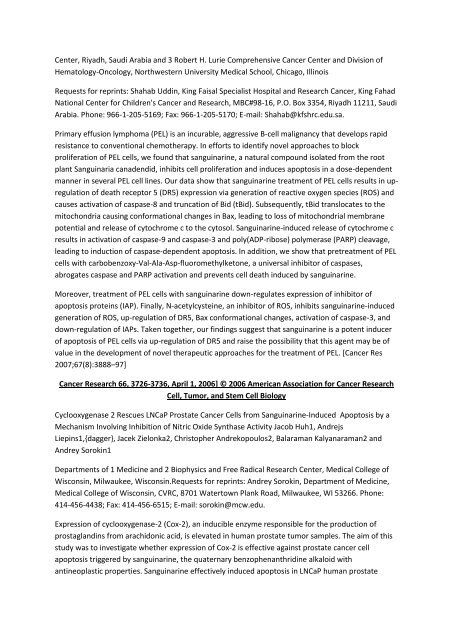Black Salve Alternative Cancer Treatment (1)
Create successful ePaper yourself
Turn your PDF publications into a flip-book with our unique Google optimized e-Paper software.
Center, Riyadh, Saudi Arabia and 3 Robert H. Lurie Comprehensive <strong>Cancer</strong> Center and Division of<br />
Hematology-Oncology, Northwestern University Medical School, Chicago, Illinois<br />
Requests for reprints: Shahab Uddin, King Faisal Specialist Hospital and Research <strong>Cancer</strong>, King Fahad<br />
National Center for Children's <strong>Cancer</strong> and Research, MBC#98-16, P.O. Box 3354, Riyadh 11211, Saudi<br />
Arabia. Phone: 966-1-205-5169; Fax: 966-1-205-5170; E-mail: Shahab@kfshrc.edu.sa.<br />
Primary effusion lymphoma (PEL) is an incurable, aggressive B-cell malignancy that develops rapid<br />
resistance to conventional chemotherapy. In efforts to identify novel approaches to block<br />
proliferation of PEL cells, we found that sanguinarine, a natural compound isolated from the root<br />
plant Sanguinaria canadendid, inhibits cell proliferation and induces apoptosis in a dose-dependent<br />
manner in several PEL cell lines. Our data show that sanguinarine treatment of PEL cells results in upregulation<br />
of death receptor 5 (DR5) expression via generation of reactive oxygen species (ROS) and<br />
causes activation of caspase-8 and truncation of Bid (tBid). Subsequently, tBid translocates to the<br />
mitochondria causing conformational changes in Bax, leading to loss of mitochondrial membrane<br />
potential and release of cytochrome c to the cytosol. Sanguinarine-induced release of cytochrome c<br />
results in activation of caspase-9 and caspase-3 and poly(ADP-ribose) polymerase (PARP) cleavage,<br />
leading to induction of caspase-dependent apoptosis. In addition, we show that pretreatment of PEL<br />
cells with carbobenzoxy-Val-Ala-Asp-fluoromethylketone, a universal inhibitor of caspases,<br />
abrogates caspase and PARP activation and prevents cell death induced by sanguinarine.<br />
Moreover, treatment of PEL cells with sanguinarine down-regulates expression of inhibitor of<br />
apoptosis proteins (IAP). Finally, N-acetylcysteine, an inhibitor of ROS, inhibits sanguinarine-induced<br />
generation of ROS, up-regulation of DR5, Bax conformational changes, activation of caspase-3, and<br />
down-regulation of IAPs. Taken together, our findings suggest that sanguinarine is a potent inducer<br />
of apoptosis of PEL cells via up-regulation of DR5 and raise the possibility that this agent may be of<br />
value in the development of novel therapeutic approaches for the treatment of PEL. [<strong>Cancer</strong> Res<br />
2007;67(8):3888–97]<br />
<strong>Cancer</strong> Research 66, 3726-3736, April 1, 2006] © 2006 American Association for <strong>Cancer</strong> Research<br />
Cell, Tumor, and Stem Cell Biology<br />
Cyclooxygenase 2 Rescues LNCaP Prostate <strong>Cancer</strong> Cells from Sanguinarine-Induced Apoptosis by a<br />
Mechanism Involving Inhibition of Nitric Oxide Synthase Activity Jacob Huh1, Andrejs<br />
Liepins1,{dagger}, Jacek Zielonka2, Christopher Andrekopoulos2, Balaraman Kalyanaraman2 and<br />
Andrey Sorokin1<br />
Departments of 1 Medicine and 2 Biophysics and Free Radical Research Center, Medical College of<br />
Wisconsin, Milwaukee, Wisconsin.Requests for reprints: Andrey Sorokin, Department of Medicine,<br />
Medical College of Wisconsin, CVRC, 8701 Watertown Plank Road, Milwaukee, WI 53266. Phone:<br />
414-456-4438; Fax: 414-456-6515; E-mail: sorokin@mcw.edu.<br />
Expression of cyclooxygenase-2 (Cox-2), an inducible enzyme responsible for the production of<br />
prostaglandins from arachidonic acid, is elevated in human prostate tumor samples. The aim of this<br />
study was to investigate whether expression of Cox-2 is effective against prostate cancer cell<br />
apoptosis triggered by sanguinarine, the quaternary benzophenanthridine alkaloid with<br />
antineoplastic properties. Sanguinarine effectively induced apoptosis in LNCaP human prostate



